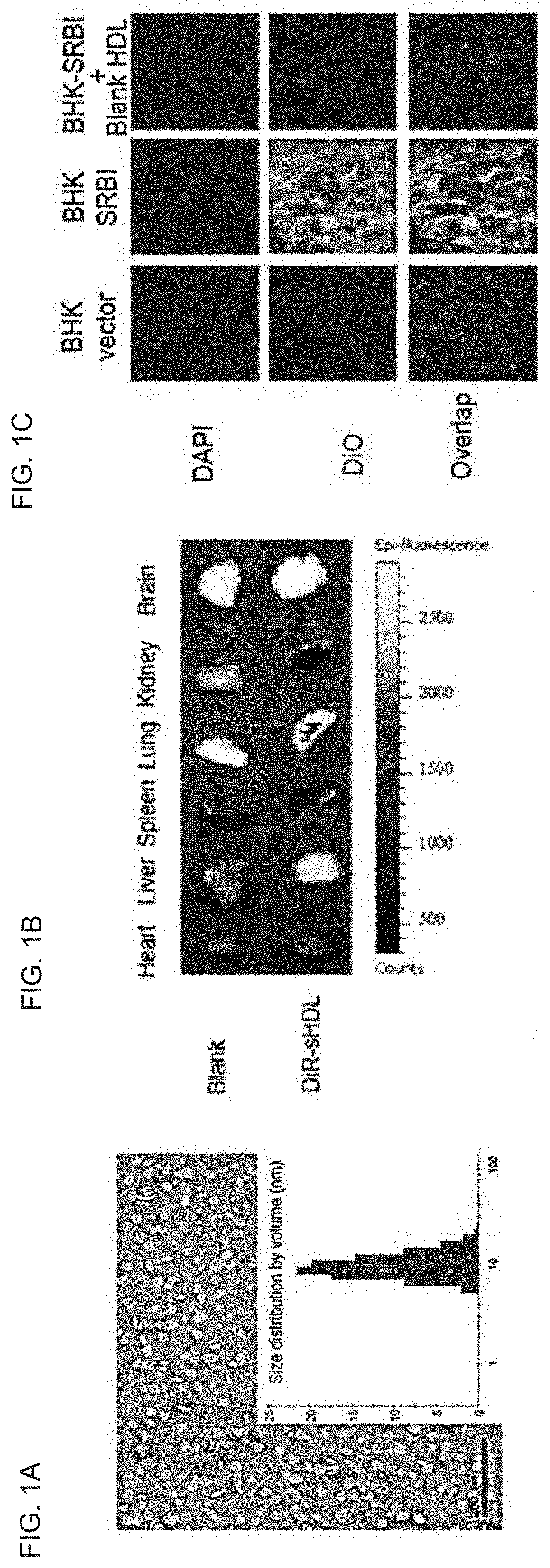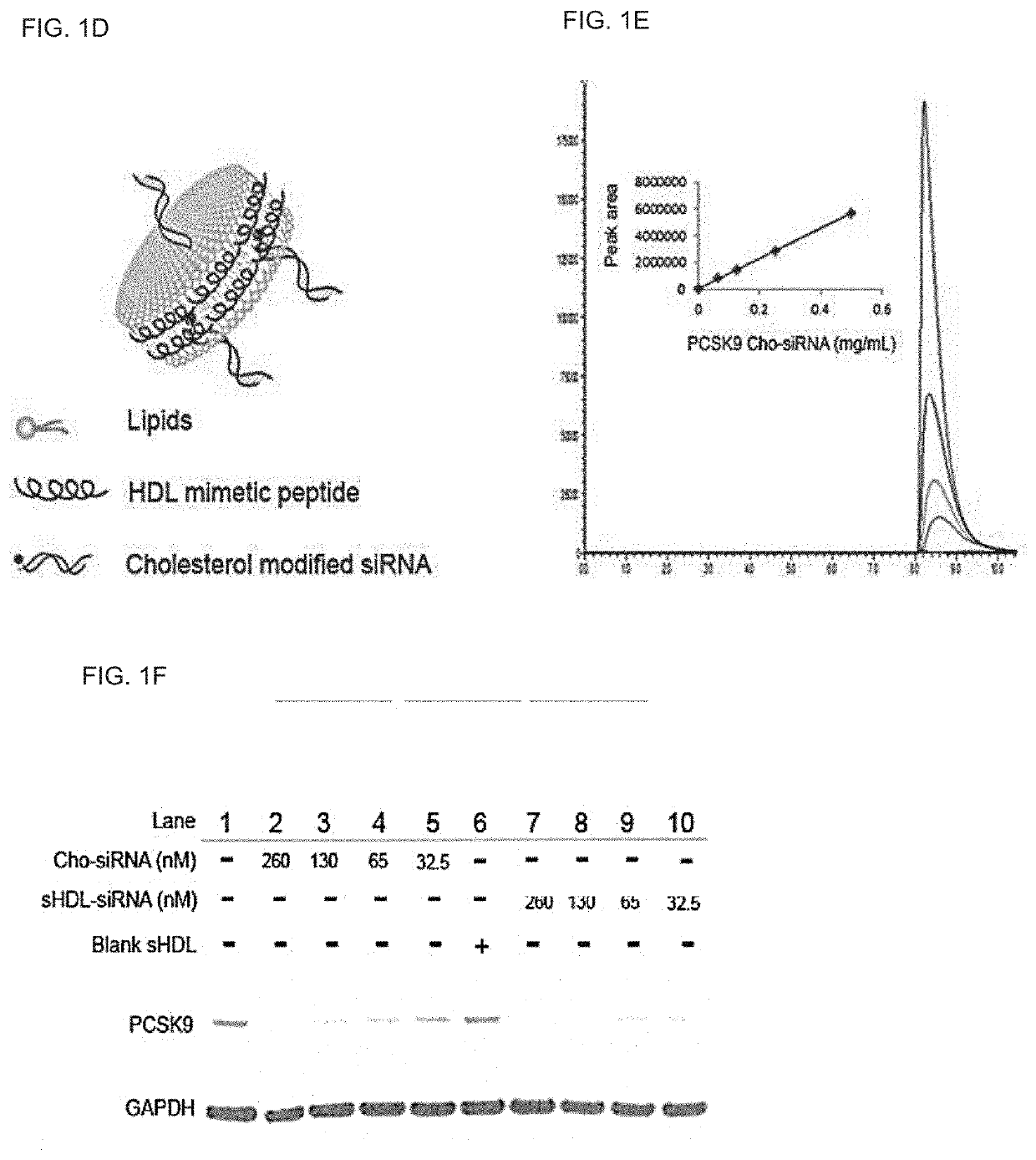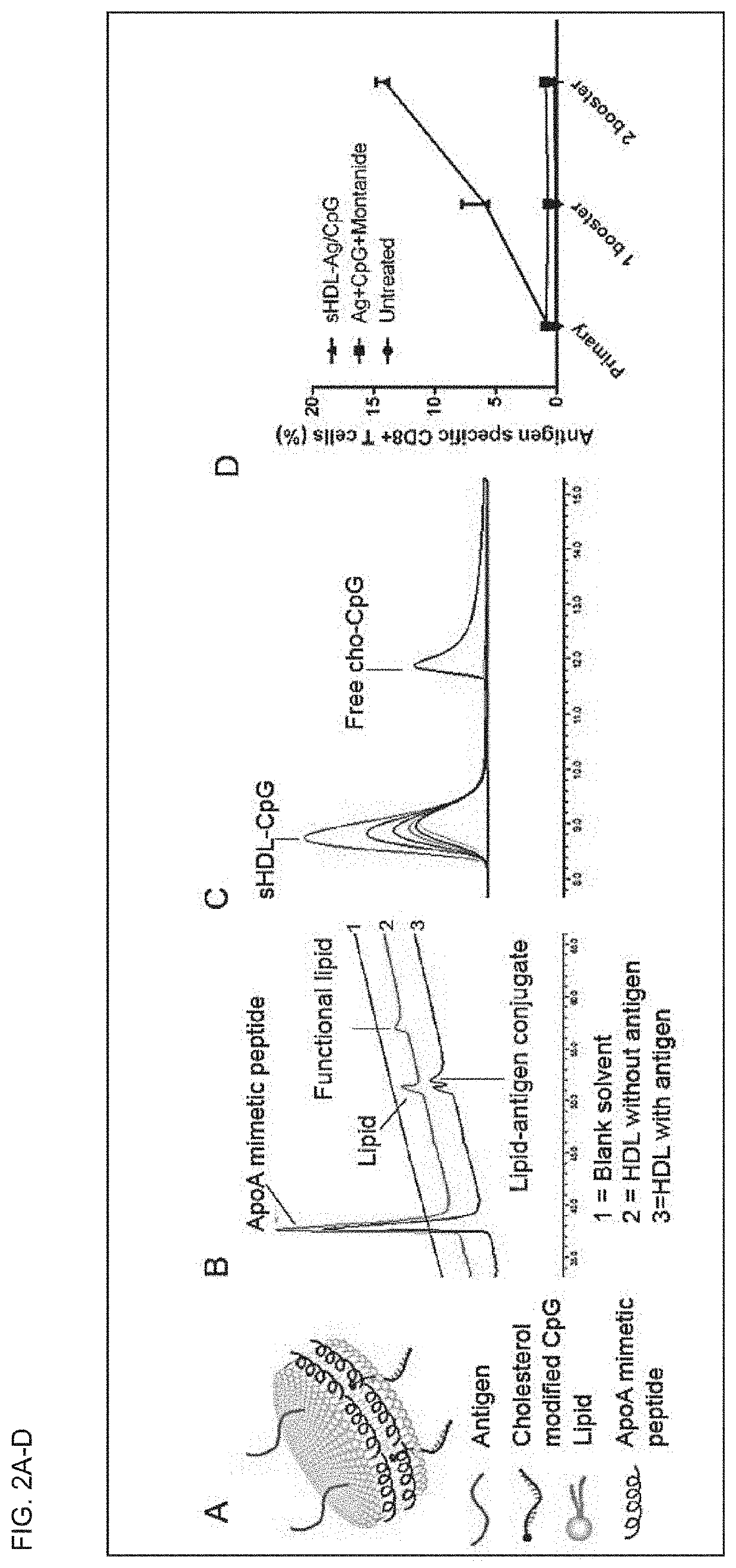Compositions and methods for delivery of biomacromolecule agents
a biomacromolecule and agent technology, applied in the field of nanoparticles complexed with biomacromolecule agents, can solve the problems of inability to demonstrate clinical efficacy, difficult clinical translation of the drug, limited human efficacy, etc., to achieve the effect of improving co-delivery of antigens, sustaining antigen presentation, and driving t-cell responses
- Summary
- Abstract
- Description
- Claims
- Application Information
AI Technical Summary
Benefits of technology
Problems solved by technology
Method used
Image
Examples
example 1
[0291]This example describes the materials and methods for synthesis of a sHDL loaded with biomacromolecules
Materials
[0292]1,2-dimyristoyl-sn-glycero-3-phosphocholine (DMPC), 1,2-dioleoyl-sn-glycero-3-phosphoethanolamine (DOPE), and rhodamine (Rhod)-labeled DOPE (DOPE-Rhod) were all purchased form Avanti Polar Lipids (Alabaster, Ala.). Dioleoyl-sn-glycero-3-phosphoethanolamine-N-[3-(2-pyridyldithio) propionate] (DOPE-PDP) was additionally synthesized. All peptides including HDL mimicking peptide (22A; SEQ ID NO: 4), SIINFEKL (SEQ ID NO: 341), CSSSIINFEKL (SEQ ID NO: 342), and FITC labeled CSSSIINFEK(FITC)L used were customized from GenScript. The oligodeoxynucleotide TLR 9 ligand CpG 1826 (5′-tccatgacgttcctgacgtt-3′, lower case letters represent phosphorothioate backbone) (SEQ ID NO: 343) and cholesterol modified CpG 1826 (5′-tccatgacgttcctgacgtt-3′-TEG-cholesterol) were ordered from Intergrated DNA Technologies. HPLC grade solvents such as methanol and acetonitrile were purchased f...
example ii
[0309]This example demonstrates that PCSK9 siRNA incorporated into sHDL can efficiently accumulate in the liver, deliver its cargo into SR-BI positive cells, and knockdown PCSK9 in HepG2 cells. Rapid and cheap lyophilization methods for the preparation of homogeneous sHDL nanoparticles were implemented. The homogeneity of the sHDL was confirmed by transmission electron microscopy (TEM), dynamic laser scattering (DLS), and gel permeation chromatography (GPC) (FIG. 1A). When sHDL was labeled by the fluorescent dye DiR and intravenously injected to mice, the majority of DiR signal was detected in the liver, with little or no signal in other organs (FIG. 1B). sHDL also efficiently delivered the fluorescent dye DiO into SR-BI positive cells (BHK-SR-BI), but not SR-BI negative cells (BHK-vector), and the uptake by SR-BI positive cells was blocked by the excess blank sHDL (FIG. 1C). Moreover, the preliminary data showed that the cholesterol modified PCSK9 siRNA (PCSK9 Cho-siRNA) could be q...
example iii
[0310]This example demonstrates that co-localized delivery of antigen and adjuvant by sHDL leads to potent immune response. FIG. 4A presents a schematic of antigens and adjuvants-loaded sHDL. When a MHC class I antigen peptide (CD8+ T cell epitope peptide SIINFEKL derived from ovalbumin) was incubated with functional lipids-containing sHDL, the antigen peptide was quantitatively conjugated to functional lipids of sHDL, as can be seen by the disappearance of functional lipids and appearance of lipid-peptide conjugates (FIG. 2B). The cholesterol modified CpG (Cho-CpG) was also shown to be quantitatively incorporated into sHDL (FIG. 2C). After 1 primary dose and two booster doses, the antigen and CpG-loaded sHDL (sHDL-Ag / CpG) elicited more potent immune responses than the mixture of antigens and CpG in Montanide (CpG+Montanide is one of the most potent experimental adjuvant currently undergoing clinical evaluations) (FIG. 2D).
[0311]FIG. 3 shows a schematic of the synthesis of sHDL-CSSS...
PUM
| Property | Measurement | Unit |
|---|---|---|
| size | aaaaa | aaaaa |
| size | aaaaa | aaaaa |
| particle size | aaaaa | aaaaa |
Abstract
Description
Claims
Application Information
 Login to View More
Login to View More - R&D
- Intellectual Property
- Life Sciences
- Materials
- Tech Scout
- Unparalleled Data Quality
- Higher Quality Content
- 60% Fewer Hallucinations
Browse by: Latest US Patents, China's latest patents, Technical Efficacy Thesaurus, Application Domain, Technology Topic, Popular Technical Reports.
© 2025 PatSnap. All rights reserved.Legal|Privacy policy|Modern Slavery Act Transparency Statement|Sitemap|About US| Contact US: help@patsnap.com



